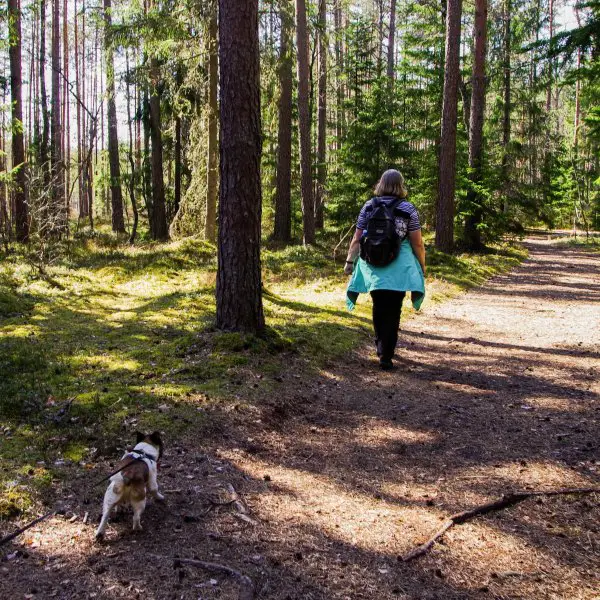The Ins and Outs of Hiking With Your Dog
 The Ins and Outs of Hiking With Your Dog
gearweare.net
The Ins and Outs of Hiking With Your Dog
gearweare.net
Hiking with friends is always better. So if you have a dog, you will want to bring them on your adventures into the woods. Not only that but frequent hiking with dogs will keep them happy and healthy. Dogs need lots of exercises to stay in shape. But, they will get lazy and soft if you let them. Bringing your dog on hikes is an excellent way to stop that from happening, and will encourage you to stay fit at the same time.
Hiking with your furry partner in crime isn’t as easy as merely heading out onto the trail though. Just like humans, dogs must build the skills and strength necessary before spending an entire day (or multiple days) exerting themselves in the outdoors. Furthermore, specific considerations must be taken to ensure that your dog stays comfortable and doesn’t bother anyone who you come across as you hike. Read on for everything you should consider before taking your dog out for some hiking.
Table of Contents
The Age of Your Dog
Although you might be eager to begin hiking with your new puppy right away, it is possible to start too soon. One thing to consider is that puppies who overexert themselves at two young ab age can damage their developing joints. For most dogs, it takes about nine months for their bodies to become fully formed, but some larger dogs may take longer. Furthermore, puppies who have not yet received all their shots may be susceptible to dangers that they otherwise wouldn’t be. If you have a puppy, talk to your veterinarian about when the best time to begin hiking with them would be.

You should take caution with taking old dogs hiking as well. Age slows dogs down as much as human, so even if your pup was an all-star hiker in its youth. As a dog moves into the double-digit years, you might have to slow it down. If your dog is ten or older, pay attention to their behavior on the trail even if everything seems fine, as this tends to be the point when ages begin to be a determining factor in hiking ability. Also, make sure to know everything about the characteristics of the breed your dog is since some breeds age more quickly than others.
The Size of Your Dog
Ability level notwithstanding, some dogs will have an easier time on some trails because of their size. That being said, any dog over 40 lbs., should be able to navigate the same terrain without any problems. The issue comes in with tiny dogs trying to get over large rocks, in which cases you may have to lift your pup to keep them moving along. Try to pick hikes that are compatible with the size of your dog to avoid having to do too much lifting or carrying.
Your Dog’s Fitness Level
You have to establish the level of a hike that your dog will be capable of. This is based on their age and size, think about how to fit your dog is. A city-dwelling pup whose typical daily routine is two goes one or two short walks over the flat ground a day will not be able to suddenly spend a full day hiking with thousands of feet of elevation gain. 
Start by doing hour long hikes with your pup and pay attention to how they are acting at the end. If they are panting and seem entirely out of breath, keep doing hikes of that length. Lengthen the walk if they seem to still be full of energy at the end. It should also be noted that starting with short hikes, then lengthening them as appropriate, will create the callus on your feet that will be important for them to stay comfortable while hiking.
Another way to assess your dog’s fitness level is to look at their body shape. You should be able to feel their ribs. However, the bones should not be poking through. Since your dog only works out when you take them, how in shape you are is also a likely indicator. If you spend more time on the couch then outdoors, your pup probably does too.
Things To Bring for Your Dog
At this point, you have established which hikes your dog would be best able to tackle. Now it’s time to think about what you need to bring for your pup. One thing that you should always have with you is a leash. It’s recommended that you bring a leash that is 10 feet long or shorter so that you can keep your dog close and under control as you pass other people on the trail.
Just like you need water and food while hiking, your pooch needs fuel to stay energized and healthy on the trail. Even if there is water along the trail, bring some extra for your dog along with a water bowl. Not all water is safe for your dog to drink, so encourage them to drink what you bring instead.
Booties for the dog are also a good idea to bring along for your pooch. Dog feet are sensitive, especially if they are more used to pavement rather than rough trails. Even if your dog does have sturdy feet, you should still bring booties in case they get a cut or splinter. You should also bring extra booties. If your dog always uses them since it is likely that they will lose one or two at some point.
A dog first aid kit is another must have on the trail. Included in this should be a rag or cooling collar to keep the pup safely cool on a hot day.
Finally, make sure to always have bags with you to pick up your dog’s waste. Dog poop is not natural and should not be left in the wild. Its smells can disrupt the interactions between wild animals. Bag it and hike it out, or bury following leave-no-trace principles. Six to 8 inches underground and 200 feet about from trails and water sources.
Trail Etiquette when Hiking with Dogs
Whether or not your dog is on a leash, they must be under your control while hiking. When off leash, this means that they are well-trained. So, this means they will obey your commands. And within ear and eyeshot so that they will notice when these commands are given. If you pass another group on the trail, call your dog over and position yourself, with your pup next to you, so that they can pass easily. Other hikers, bikers, and horses have the right of way in this situation.
Always keep the ratio of dogs to humans as 1:1 when hiking. It is hard to manage two dogs as one person. Furthermore, never hike with more than two dogs at a time, even if there are more people than that in your group. Three or more dogs become a pack, which can quickly become difficult to control.
The final aspect of trail etiquette is knowing if the trail allows dogs to be there at all. Many don’t, so always check beforehand. Furthermore, some trails allow dogs, but only if they are on a leash. Be a good steward for the community of dog owners and remember that breaking the rules could result in everyone losing their ability to bring their best friend to a particular area.
Potential Hazards of Hiking with Dogs
Dogs face many of the same hazards as we do when hiking. The big difference is that they won’t be aware of these hazards in the same way as us. Keep them leashed in areas where there are cliffs, poisonous or harmful plants, and wild animals that could harm them.
One hazard that needs to be accounted for with dogs that is unique to them is the fact that they don’t regulate heat well. On hot days maybe opt for a more mellow hike. So that your pup isn’t in danger of developing heat stroke. Furthermore, keep an eye on them, and if they seem to be panting extensively, stop in some shade to rest and try to find some water to help them cool off.











